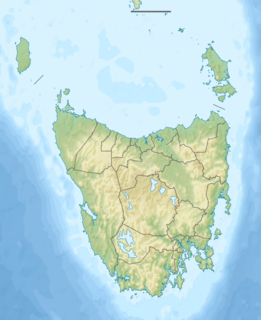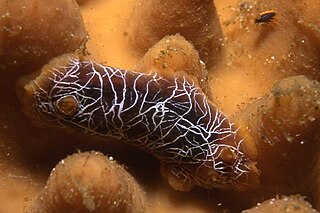
Bass Strait is a strait separating the island state of Tasmania from the Australian mainland. The strait provides the most direct waterway between the Great Australian Bight and the Tasman Sea, and is also the only maritime route into the economically prominent Port Phillip Bay.

The Gulf of St. Lawrence is the outlet of the North American Great Lakes via the St. Lawrence River into the Atlantic Ocean. The gulf is a semi-enclosed sea, covering an area of about 226,000 square kilometres (87,000 sq mi) and containing about 34,500 cubic kilometres (8,300 cu mi) of water, which results in an average depth of 152 metres (499 ft).

Cabot Strait is a strait in eastern Canada approximately 110 kilometres wide between Cape Ray, Newfoundland and Cape North, Cape Breton Island. It is the widest of the three outlets for the Gulf of Saint Lawrence into the Atlantic Ocean, the others being the Strait of Belle Isle and Strait of Canso. It is named for the Genoese explorer Giovanni Caboto.

Cook Strait separates the North and South Islands of New Zealand. The strait connects the Tasman Sea on the northwest with the South Pacific Ocean on the southeast, and runs next to the capital city, Wellington. It is 22 kilometres (14 mi) wide at its narrowest point, and is considered one of the most dangerous and unpredictable waters in the world. Regular ferry services run between Picton in the Marlborough Sounds and Wellington.

Located in the eastern part of Canada, and part of Central Canada, Quebec occupies a territory nearly three times the size of France or Texas, and is much closer to the size of Alaska. As is the case with Alaska, most of the land in Quebec is very sparsely populated. Its topography is very different from one region to another due to the varying composition of the ground, the climate, and the proximity to water. The Great Lakes–St. Lawrence Lowlands and the Appalachians are the two main topographic regions in southern Quebec, while the Canadian Shield occupies most of central and northern Quebec.

The Celebes Sea of the western Pacific Ocean is bordered on the north by the Sulu Archipelago and Sulu Sea and Mindanao Island of the Philippines, on the east by the Sangihe Islands chain, on the south by Sulawesi's Minahasa Peninsula, and on the west by northern Kalimantan in Indonesia. It extends 420 miles (675 km) north-south by 520 mi (840 km) east-west and has a total surface area of 110,000 square miles (280,000 km2), to a maximum depth of 20,300 feet (6,200 m). South of the Cape Mangkalihat, the sea opens southwest through the Makassar Strait into the Java Sea.

Cape Chidley is a headland located on the eastern shore of Killiniq Island, Canada at the northeastern tip of the Labrador Peninsula.

Whelk is a common name that is applied to various kinds of sea snail. Although a number of whelks are relatively large and are in the family Buccinidae, the word whelk is also applied to some other marine gastropod species within several families of sea snails that are not very closely related.

Buccinum is a genus of medium-sized sea snails, marine gastropod molluscs in the family Buccinidae, the true whelks.

The Laurentian Channel is a deep submarine valley off the coast of eastern Canada in the Gulf of Saint Lawrence.

Buccinum undatum, the common whelk or the waved buccinum, is a large, edible marine gastropod in the family Buccinidae, the "true whelks".

The Northwest Atlantic Marine Ecozone, as defined by the Commission for Environmental Cooperation (CEC), is a Canadian marine ecozone forming a transitional region between the cold northern waters of the Arctic Ocean and the more temperate waters in its southern extent.

Bolocera tuediae, commonly known as the deeplet sea anemone, is a sea anemone found in the sublittoral zone of the North Sea. It was first discovered near Bewick, England by Johnston in 1832. It is distinguished by its large, hexamerous size and shedding of tentacles. The nematocysts of the anemone can have dangerous effects, including the rupturing of human blood cells. The deeplet sea anemone was observed to have a symbiotic relationship with shrimp, as they cluster around its base in both temperate and Northwest Atlantic waters.

The scribbled nudibranch is a species of sea slug, a dorid nudibranch. It is a marine gastropod mollusc in the family Dendrodorididae.

Buccinum plectrum is a species of sea snail, a marine gastropod mollusk in the family Buccinidae, the true whelks.

The Eastern Canadian forests is a taiga ecoregion in Eastern Canada, as defined by the World Wildlife Fund (WWF) categorization system.

Ziminella salmonacea, common name the salmon aeolis, is a species of sea slug, an aeolid nudibranch, a marine gastropod mollusc in the family Paracoryphellidae.

Bucephalidae is a family of trematodes that parasitize fish. They lack suckers, having instead a muscular organ called a "rhynchus" at the front end which they use to attach to their hosts. The characteristics of the rhynchus are used to help define the genera of the family. It is one of the largest digenean families, with 25 genera containing hundreds of described species. Bucephalids are cosmopolitan, having been recorded all over the world. They are parasites of fish from freshwater, marine, and brackish water habitat types.

Calliactis parasitica is a species of sea anemone associated with hermit crabs. It lives in the eastern Atlantic Ocean and Mediterranean Sea at depths between the intertidal zone and 60 m (200 ft). It is up to 10 cm × 8 cm in size, with up to 700 tentacles, and is very variable in colour. The relationship between C. parasitica and the hermit crab is mutualistic: the sea anemone protects the hermit crab with its stings, and benefits from the food thrown up by the hermit crab's movements.
Aartsenia candida is a species of sea snail, a marine gastropod mollusk in the family Pyramidellidae, the pyrams and their allies. The species is one of the two species within the Aartsenia genus, with the exception of the other related species being Aartsenia arctica.



















